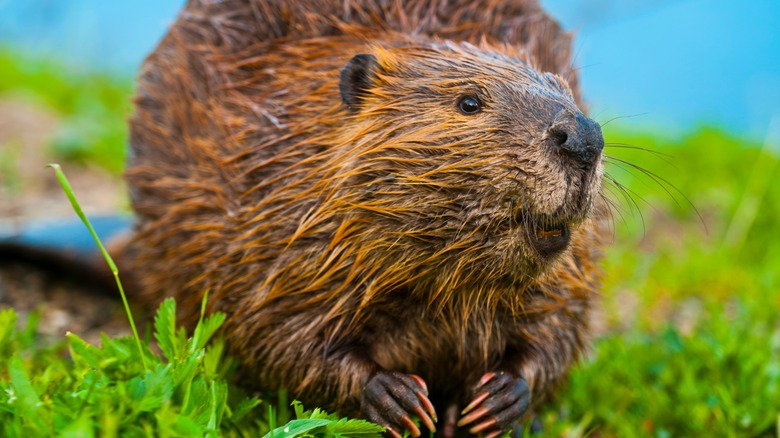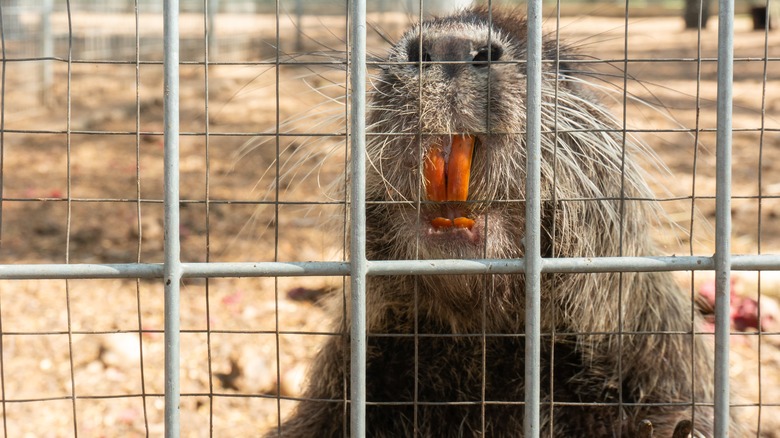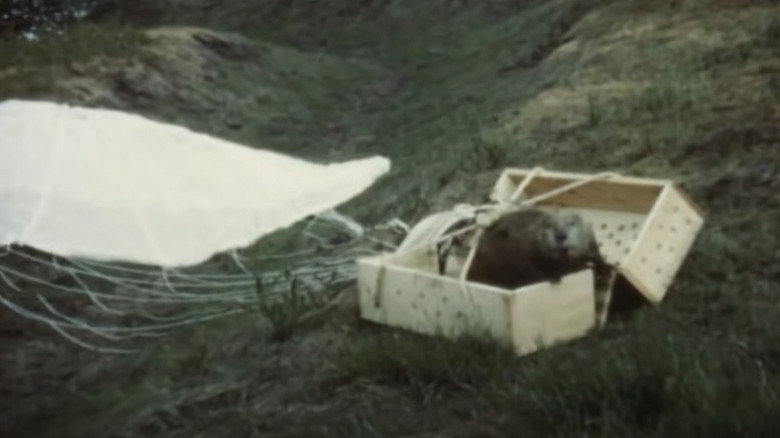Why 76 Beavers Parachuted From Planes After World War II
The C-47 soars high above enemy territory. Within its body are elite paratroopers, well-trained and eager for the chance to do their bit for the Allies. Nazi searchlights sweep the skies, hoping to intercept any approaching forces, but one brave commando parachutes in, heedless of the enemy below. He's so heedless, in fact, that he sings "She Was Poor but She Was Honest" as he drifts down to the searchlights, where his first order of business is to make shadow puppets. Though one wonders why he bothered with a parachute at all; couldn't a duck just fly down?
That, of course, is an exploit of Daffy Duck during World War II, when he and many other animal cartoon stars appeared in a slew of propaganda films to boost home morale and thumb America's nose at the Nazis. Real paratroopers couldn't lazily drift into Germany singing seriocomic folk songs, and they didn't have the option of using wings; they really needed their nylon parachutes. Companies on the home front were more than capable of meeting that need, to the point that supply outstripped demand. Parachutes were among many items of war that the military had in surplus after World War II concluded.
All those extra parachutes were just lying around when families began moving west in the postwar years, bringing them into contact and conflict with local wildlife. In 1948, that conflict and all that spare nylon came together in a bizarre but successful scheme by the Fish and Game Department to make parachutists out of some real-life animals — not ducks, but beavers.
New Idaho residents didn't want to share their home with beavers
Beavers are an easy animal for many of us to love. They're not only cute, they're industrious, and their dam-building helps to keep the ecosystems in which they live healthy. Beaver dams help to slow the flow of streams and rivers, minimizing soil erosion, and ponds formed by those dams replenish groundwater supplies. Beaver ponds become home for many other animals. And the dams act as natural filters to flowing water, improving the quality downstream.
But beaver dams can also raise stream temperatures upstream and sap oxygen from the water in the long term. And beavers can do a number on crops and home gardens. That was the chief complaint of families who relocated from the big city to southwest Idaho in the years immediately after World War II, according to National Geographic. That region of the state was full of beavers, beavers with no conception of private property or the proper maintenance of sprinkler systems. The new homeowners started to lobby complaints about their rodent neighbors.
Relocating beavers by land was expensive and dangerous
Responsibility for removing southwest Idaho's beavers from new human settlements lay with the Fish and Game Department, and how to do it was a big problem for the agency. They didn't want to kill the beavers; department members knew their value to the local ecosystem, and there was a concerted effort at the time to restore beaver populations after decades of overhunting. But if they were to be moved instead of destroyed, where would they be put?
Central Idaho holds a protected region, the Frank Church-River of No Return Wilderness area. In that area is the Chamberlain Basin, a spot with plenty of woods and a prominent creek. It seemed like the ideal place to relocate the beavers. Having a place to put them, however, still left the question of how to get them there. Such wildlife relocations were unusual in 1948, and the methods used in the past — trapping the animals, carrying them by horse or mule to a truck, and driving them to the road nearest their new home — had significant drawbacks.
"The ... method of transportation was arduous, prolonged, expensive, and resulted in high mortality," wrote Fish and Game employee Elmo W. Heter in a Journal of Wildlife Management article. Several factors affected beaver mortality rates on such trips. Their smell disturbed the horses responsible for carrying them. Capture and transport understandably upset many beavers, making them quarrelsome. And beavers have a low heat tolerance when they're out of the water. The stress of heat and travel was so tough that some of the beavers refused to eat after a while.
A Fish and Game employee had the idea of using parachutes to move beavers
Having written on the problems of the old way of transporting pesky beavers, Elmo W. Heter set about finding a better way. He worked out that it was better to move them in midsummer; their migration season was finished and they'd have time to acclimate to their new home. And he knew from past relocation efforts that it was better to move young beavers, ideally four at a time with either one male to three females or two of each. But the question still remained: how would the beavers be moved?
Heter was the one who came up with the idea of using military surplus parachutes to drop the beavers into their new home from a plane. As kooky as it might look on paper, it was at least economic; per Boise State Public Radio, it would only cost $30, or $379.30 in 2024 currency. But since beavers, then and now, don't have the ability to operate a standard parachute, Heter had to devise transport crates that could be safely taken down from a plane, and that the beavers could easily get out of once they landed.
The crate design demanded a fair amount of trial and error. The first design was made of woven willow, a favorite beaver food. But that proved the fatal flaw in the design. Beavers put into those crates went to town on them immediately. If they'd been used, the beavers could've gotten free in loading, on the plane, or in midair.
76 beavers were moved by parachute
Elmo Heter's final design for his beaver parachute crates used two wooden boxes with airholes and a hinge that would snap open on landing. The two-box system let Heter drop two beavers at once, a practice that seemed to keep the beavers from migrating too soon after landing. But the initial guinea pig for the whole operation, an old male named Geronimo, flew solo. Using a landing field, Heter flew test flight after test flight, dropping Geronimo, his crate, and his parachute. Every time, the chute carried the beaver safely down to where handlers were waiting to catch him, load him, and run the whole thing over. Heter later reported that Geronimo eventually realized what was happening and crawled back into his crate on his own when he saw the department men approach.
Geronimo, along with three females, became the first of 76 beavers relocated from Southwest Idaho to the Chamberlain Basin once the parachute method was cleared. They were dropped into meadows in the region in a series of flights over several days. All but one of the beavers survived the journey; the lone casualty managed to crawl on top of his crate and either jumped or fell at 75 feet above ground. Compared to the older transportation methods, the animals were healthier after the trip and better equipped to pick up their lives. One exception, at least initially, was Geronimo; while he and his females eventually established a robust colony, it took him a while to realize he wasn't going to be loaded up for another drop and he was slow to exit the box upon landing.
A film on the beavers was uncovered in 2014
The descendants of the 76 beaver parachutists are still in the Chamberlain Basin, and they've been credited with helping to keep the region, the largest roadless forest south of Alaska, thriving. But the experiment was never repeated. Once the beavers were moved, there wasn't a need to move them again. As times and attitudes changed, homeowners were more likely to be encouraged to live with local wildlife. Technology lets wildlife departments keep animals where they are these days while minimizing the damage they can cause. And although parachuting was an improvement over horse and truck, the stress of moving still likely took its toll on the beavers.
The flight of the Idahoan beavers remained a successful but obscure operation until Idaho Fish and Game historian Sharon Clark was told the story by a former department fur trapper. Not only did he fill Clark in on the mission, he said that a documentary short had been made on it, a film apparently lost to time. Fascinated by the story, Clark set about finding the film. After a yearslong search, she finally got her hands on it in 2014, in a mislabeled and misfiled canister. Once it was digitally scanned, the film was put on YouTube, where it was quickly picked up by multiple news agencies and introduced a new generation to one of the wackiest success stories of postwar wildlife management.




